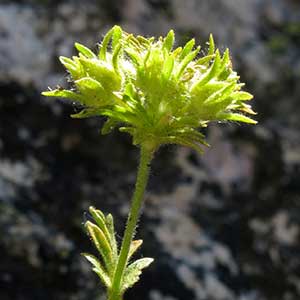Ivesia sericoleuca
Ivesia longibracteata
Plumas ivesia, Plumas mousetail
Castle Crags ivesia, longbract mousetail
decumbent to ascending, 1.5–4.5 dm.
ascending to erect, 0.3–1.2 dm.
10–20(–30) cm; sheathing base densely strigose abaxially;
stipules absent;
petiole 2–6(–10) cm, hairs abundant, usually spreading, 1–4 mm;
leaflets 20–35 per side, loosely overlapping, 3–15 mm, lobes 0–4, oblanceolate to elliptic, hairs abundant, spreading to ascending, (0.5–)1–3(–4) mm.
weakly planar to loosely ± cylindric, (0.5–)2–4(–6) cm; sheathing base glandular abaxially, otherwise glabrous;
petiole 0.5–2 cm, hairs 0.2–1 mm;
leaflets 5–6 per side, 2–6 mm, ± short-hirsute, glandular-puberulent, lobes 2–7, oblanceolate to spatulate or obovate, apex not setose.
3–8(–10).
1–3, not paired.
20–120-flowered, (2–)4–14 cm diam., flowers mostly arranged in several to many tight glomerules of 5–10 flowers.
3–14-flowered, 1–2.5 cm diam.;
glomerules 1.
1–3(–12) mm.
1.5–6 mm.
10–15 mm diam.;
epicalyx bractlets narrowly lanceolate to narrowly elliptic, (1.5–)2–2.5(–3) mm;
hypanthium campanulate to shallowly turbinate, 1.5–3 × 2.5–4.5(–5) mm, often nearly as deep as wide;
sepals sometimes purple-suffused, 3–5.5 mm, acute to acuminate;
petals white, broadly spatulate to broadly obovate or obcordate, 4–7 mm;
stamens 20, filaments filiform, 1.5–3 mm, anthers white to cream, 0.5–0.7 mm;
carpels 2–7, styles 2.5–4 mm.
8–10 mm diam.;
epicalyx bractlets linear to narrowly lanceolate or elliptic, 2.5–5 mm, longer than sepals;
hypanthium shallowly cupulate, 0.5–1 × 2–3 mm;
sepals 1.5–2.5 mm, ± acute;
petals pale yellow, linear to narrowly oblanceolate, 1.5–2.5 mm;
stamens 5, filaments 0.7–1.3 mm, anthers yellow, 0.5–0.8 mm;
carpels 6–11, styles 1–1.5 mm.
brown, 2–3 mm.
cream to light tan, 1.2–1.5 mm.
= 28.
Ivesia sericoleuca
Ivesia longibracteata
Of conservation concern.
Ivesia sericoleuca is known from valleys and flats in the northern Sierra Nevada. Many historic collections were identified and distributed as I. unguiculata, and circumscriptions prior to 1962 include I. aperta (hence reports from Nevada).
Hairs are usually dense in plants of Ivesia sericoleuca, such that the leaves, and occasionally the stems and branches, are silvery gray, especially in Sierra Valley and the Feather River drainage. Plants in the Truckee River drainage tend to be less hairy with redder stems, less glomerate inflorescences, shallower hypanthia, and more conspicuous glandularity.
As mentioned by J. T. Howell (1962), the chromosome count given for Ivesia sericoleuca by P. A. Munz (1959) most likely was based on a collection of I. aperta var. aperta. The chromosome count given here is instead based on Kruckeberg 3665, originally distributed as I. pickeringii.
(Discussion copyrighted by Flora of North America; reprinted with permission.)
Of conservation concern.
Ivesia longibracteata is known only from the Castle Crags area of Shasta County. The epithet alludes to a diagnostic characteristic unique in the genus: the epicalyx bractlets are longer than the sepals. The plants grow on vertical rock faces, a habitat more characteristic of sect. Setosae; however, the stems are ascending to erect and do not form hanging clumps, and the pedicels are not curved in fruit.
(Discussion copyrighted by Flora of North America; reprinted with permission.)


